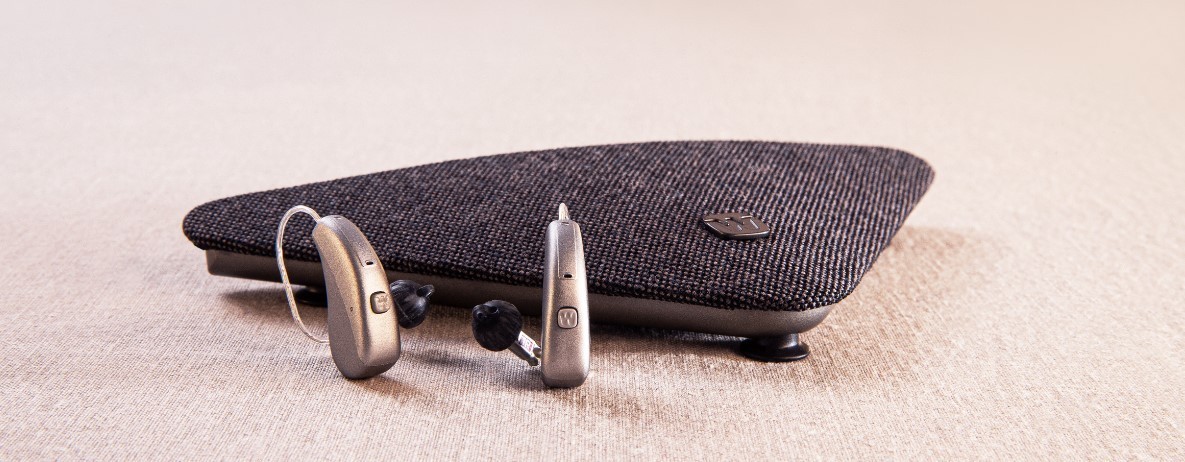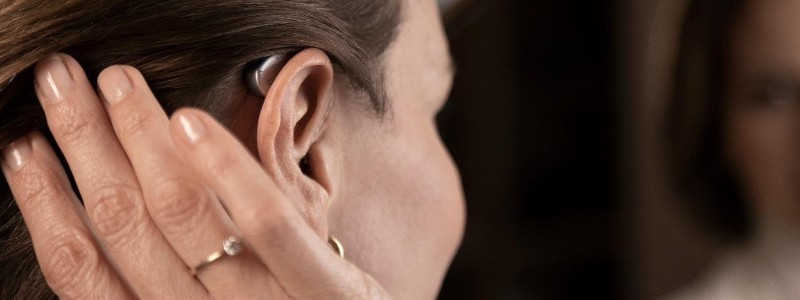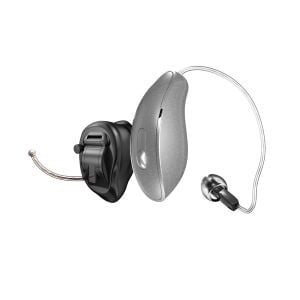Free home visits
with a local audiologist

Head of Online Medical Content

Audiology Expert at Hearing Aid UK

Hearing aid tech in 2025 | AI and Biometrics | Developments | An Auracast future | Conclusion |
It is difficult to predict exactly what hearing aid technology will look like in 2025, as the field is constantly evolving and new technologies are being developed. However, we will likely see a continued trend toward the integration of artificial intelligence (AI), and collaborative ecosystems.
When people predict hearing aid technology advancements or how any industry is going to move forward it is no easy feat. The rate at which digital hearing aid technology has advanced over the last few years has given rise to increased competition within the industry itself. Inspiring consumers to want, need, and expect more.
Although hearing aids still consist of four main parts, today's hearing aids give consumers far more than those of the past. They have switched to, in some cases, complete automation and features that support hearing loss needs in all environments. This article goes through the audiology progressions so far and what we could look forward to in 2025.

As we move into 2025, hearing aid technology is expected to continue evolving at a rapid pace, integrating even more advanced features to offer a more personalised and connected experience for wearers. Artificial intelligence (AI) will play an important role, with hearing aids becoming even smarter and more adaptive.
AI algorithms will enhance real-time adjustments based on the environment, ensuring clearer sound quality, especially in complex, noisy situations like restaurants or family gatherings. These devices will be able to distinguish important sounds from background noise with increasing accuracy, making them much more effective in challenging listening environments.
Another exciting development is the growth of biometric sensors and health monitoring. Building on the success of features like heart rate sensors seen back in 2023, 2025 could bring even more advanced monitoring, with hearing aids tracking additional health metrics such as stress levels, physical activity, and sleep patterns.
This integration will not only optimise hearing aid performance but also provide valuable health insights for wearers, offering a comprehensive approach to well-being.
AI hearing aids are not a one-size-fits-all solution, and their effectiveness can vary. While they represent a step forward compared to older models, they are not without limitations. In certain situations, the AI algorithms might struggle to accurately identify and prioritise all sound sources, or they may require further adjustments to meet individual hearing needs.
The level of sophistication of the AI features can also differ from model to model, meaning not all devices perform at the same level.
For those with mild to moderate hearing loss, AI hearing aids can be incredibly beneficial, offering greater ease and clarity in everyday listening. However, those with more complex hearing challenges may still find that traditional hearing aids with manual controls better suit their needs.
Ultimately, whether AI hearing aids are the right choice depends on your specific hearing requirements and how well the technology aligns with your lifestyle. Consulting with an audiologist is always a good step to ensure you select the best hearing aid for your unique situation.
In terms of design, hearing aids will likely become even smaller, more discreet, and increasingly eco-conscious. With consumers becoming more environmentally aware, the demand for rechargeable and sustainable hearing aids is likely to grow.
We can expect to see more hearing aids designed with eco-friendly materials and more efficient energy usage, reducing the number of disposable batteries that contribute to landfill waste.
Rechargeable pods will also become smaller, making it easier to charge their devices on the go. In addition to improved sound quality and design, expect further advancements in connectivity.
Bluetooth technology will continue to evolve, allowing hearing aids to seamlessly connect with an even wider range of devices, from smartphones and smart TVs to smart home systems. This will enhance the overall user experience, making hearing aids more integrated into daily life.
Auracast is expected to be ready by mid-late 2025. Auracast technology is expected to revolutionise the way hearing aids interact with the world around them.
This innovative wireless audio streaming technology will allow wearers to seamlessly connect their hearing aids to public sound systems, such as those in theatres, airports, or sports venues, delivering personalised sound directly to their devices.
With Auracast, hearing aid wearers will no longer need special receivers or additional equipment to enhance their listening experience in large public spaces. This development promises greater convenience, improved accessibility, and an overall enhanced auditory experience for those with hearing loss.
The effectiveness of Auracast in real-world scenarios will largely depend on how widely the necessary supporting technology is adopted. Public venues will need to install systems that are compatible with Auracast, which may take some time.
While it can enhance sound quality in certain environments, it won’t be a solution for every aspect of hearing loss, particularly in quieter, more personal settings like one-on-one conversations.

Finally, the stigma around hearing aids is likely to continue fading, thanks in part to the rise of "hearables" and over-the-counter (OTC) options. With improved accessibility and greater acceptance of hearing aids as a common, even fashionable, device, more people will seek professional help earlier, improving their hearing health outcomes.
Overall, the future of hearing aids promises to be more connected, personalised, and sustainable, transforming how we think about hearing and auditory health in the years to come.
In conclusion, hearing aid technology in 2025 is ready for exciting advancements, driven by the integration of artificial intelligence, biometric sensors, and improved connectivity. With AI making hearing aids smarter and more adaptive, wearers can expect clearer sound quality in even the most challenging environments.
The growth of health monitoring features will offer a more comprehensive approach to well-being.
Design innovations, such as smaller, eco-friendly devices and enhanced Bluetooth connectivity, will further elevate the user experience. As the stigma surrounding hearing aids continues to fade, we can expect these devices to become more accessible, personalised, and sustainable, transforming the way we manage hearing health in the years ahead.
Here, at Hearing Aid UK, we are looking forward to seeing how the audiology industry unravels in regards to 2025 hearing aid launches, new hearing aid platforms and additional styles.
If you would like to discuss anything within this article or would like any advice on hearing healthcare, hearing aids or how we can support you locally - call us free on 0800 567 7621
 Starkey Edge AI Hearing Aids VS Starkey Genesis AI
Starkey Edge AI Hearing Aids VS Starkey Genesis AI  Phonak Audeo Infinio VS Phonak Lumity Hearing Aids
Phonak Audeo Infinio VS Phonak Lumity Hearing Aids  What is Auracast? Is it better than Classic Bluetooth?
What is Auracast? Is it better than Classic Bluetooth? Do not spend hundreds of pounds without getting a second opinion from us.
 Not only are the prices great, but the service is fantastic! Many thanks to your team.
Not only are the prices great, but the service is fantastic! Many thanks to your team.If you are looking at this page then it is likely that an audiologist has suggested that you purchase this particular hearing aid, so is this the best model for you?
In general, any audiologist will always recommend to you the model that best suits your needs. Here is a useful checklist to make sure that is the case.
If in doubt, feel free to give us a call. That's what we're here for. In the meantime, read all about our review of the best hearing aids for 2025 here
If you have significant hearing loss in both ears, you should be wearing two hearing aids. Here are the audiological reasons why:
Localisation: The brain decodes information from both ears and compares and contrasts them. By analysing the minuscule time delays as well as the difference in the loudness of each sound reaching the ears, the person is able to accurately locate a sound source. Simply put, if you have better hearing on one side than the other, you can't accurately tell what direction sounds are coming from.
Less amplification is required: A phenomenon known as “binaural summation” means that the hearing aids can be set at a lower and more natural volume setting than if you wore only one hearing aid.
Head shadow effect: High frequencies, the part of your hearing that gives clarity and meaning to speech sounds, cannot bend around your head. Only low frequencies can. Therefore if someone is talking on your unaided side you are likely to hear that they are speaking, but be unable to tell what they have said.
Noise reduction: The brain has its own built-in noise reduction which is only really effective when it is receiving information from both ears. If only one ear is aided, even with the best hearing aid in the world, it will be difficult for you to hear in background noise as your brain is trying to retain all of the sounds (including background noise) rather than filtering it out.
Sound quality: We are designed to hear in stereo. Only hearing from one side sounds a lot less natural to us.
Fancy some further reading on this topic? You can read about why two hearing aids are better than one in our article, hearing aids for both ears, here
For most people, the main benefit of a rechargeable hearing aid is simple convenience. We are used to plugging in our phones and other devices overnight for them to charge up. Here are some other pros and cons:
For anybody with poor dexterity or issues with their fingers, having a rechargeable aid makes a huge difference as normal hearing aid batteries are quite small and some people find them fiddly to change.
One downside is that if you forget to charge your hearing aid, then it is a problem that can't be instantly fixed. For most a 30-minute charge will get you at least two or three hours of hearing, but if you are the type of person who is likely to forget to plug them in regularly then you're probably better off with standard batteries.
Rechargeable aids are also a little bit bigger and are only available in Behind the Ear models.
Finally, just like with a mobile phone, the amount of charge you get on day one is not going to be the same as you get a few years down the line. Be sure to ask what the policy is with the manufacturer warranty when it comes to replacing the battery.
Looking for more information on rechargeable hearing aids? Read our dedicated page on the topic here
For most people, the answer is yes. But it's never that simple.
The majority of hearing problems affect the high frequencies a lot more than the low ones. Therefore open fitting hearing aids sound a lot more natural and ones that block your ears up can make your own voice sound like you are talking with your head in a bucket. Therefore in-ear aids tend to be less natural.
However the true answer is we can't tell until we have had a look in your ears to assess the size of your ear canal, and until we have tested your hearing to see which frequencies are being affected.
People with wider ear canals tend to have more flexibility, also there are open fitting modular CIC hearing aids now that do not block your ears.
There is also the age old rule to consider, that a hearing aid will not help you if it's sat in the drawer gathering dust. If the only hearing aid you would be happy wearing is one that people can't see, then that's what you should get.
Most people can adapt to any type of hearing aid, as long as they know what to expect. Have an honest conversation with your audiologist as to what your needs are.
Generally speaking, six or more. Unless it's none at all.
The number of channels a hearing aid has is often a simplistic way an audiologist will use to explain why one hearing aid is better than another, but channels are complex and it is really not that straightforward. Here are some reasons why:
Hearing aids amplify sounds of different frequencies by different amounts. Most people have lost more high frequencies than low and therefore need more amplification in the high frequencies. The range of sounds you hear are split into frequency bands or channels and the hearing aids are set to provide the right amount of hearing at each frequency level.
Less than six channels and this cannot be done with much accuracy, so six is the magic number. However, a six channel aid is typically very basic with few other features and is suitable only for hearing a single speaker in a quiet room. The number of channels is not what you should be looking at, it's more the rest of the technology that comes with them.
As a final note, different manufacturers have different approaches. One method is not necessarily better than any other. For example, some manufacturers have as many as 64 channels in their top aids. Most tend to have between 17 and 20. One manufacturer has no channels at all.
Hearing aids are easily lost, misplaced or damaged and typically are one of the most expensive personal possessions an individual can own. We offer hearing aid warranty coverage for £80 per year per aid. Find out more about this service we provide here
All our audiologists use the very latest technology and provide the full range of tests to accurately measure your hearing for free. Find out about what hearing healthcare services we offer all our customers here
Hearing Aid UK offers all their customers free home visiting services, even in a care home environment, for no extra cost. Including hearing tests, fittings, maintenance, check-ups and much more in the comfort of your own home and at your convenience. Find out more information about our home visits here
Here, at Hearing Aid UK, we are dedicated to offering low hearing aid prices. We achieve this by having no head office and low marketing costs. Our hearing aid prices are amongst the lowest you will find anywhere in the world. Explore our prices, brands, and models here
When we refer to a product as 'Latest Launch', we mean it is the latest to be released on the market.
When we refer to a product as 'New', we mean that the product is the newest hearing aid model on the market.
When we refer to a product as 'Superseded', we mean that there is a newer range available which replaces and improves on this product.
When we refer to a product as an 'Older Model', we mean that it is has been superseded by at least two more recent hearing aid ranges.